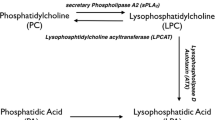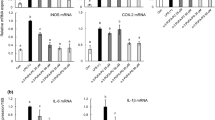Abstract
Objective
The aim of this study was to examine the inflammation induced by saturated acyl lysophosphatidylcholine (LPC) in vivo and to investigate whether it could be attenuated by the action of polyunsaturated acyl lysophosphatidylcholines (LPCs), which are known as anti-inflammatory lipid mediators.
Methods
First, saturated acyl LPC was administered intraperitoneally (i.p.) to mice and the inflammatory profile was extensively characterized. Subsequently, the preventive effect of polyunsaturated acyl LPCs, i.p. administered 30 min after saturated acyl LPC, was evaluated by measuring indices of inflammation such as leukocyte migration, plasma leakage, and eicosanoid or cytokine formation by light microscopy, Evans blue dye as indicator, and enzyme-linked immunosorbent assay, respectively.
Results
Saturated acyl LPCs as LPC16:0 (100 mg/kg, i.p.) proved to be an effective inflammation inducer which causes a significant increase in plasma leakage, leukocyte migration into peritoneum and elevation of pro-inflammatory mediators. Interestingly, LPC20:4 and LPC22:6 (50 and 150 μg/kg) significantly nullified LPC16:0-induced inflammation. The anti-inflammatory effects of LPC20:4 and LPC22:6 were related to down-regulation of leukocyte extravasation, plasma leakage, and formation of pro-inflammatory mediators (IL-5, IL-6, NO, 12-HETE and PGE2) stimulated by LPC16:0, and up-regulation of anti-inflammatory mediators (IL-4 and IL-10).
Conclusion
These results indicated that the pro-inflammatory activity of saturated acyl LPCs could be antagonized by the actions of polyunsaturated acyl LPCs, anti-inflammatory lipid mediators.








Similar content being viewed by others
Abbreviations
- AA:
-
Arachidonic acid
- LPC14:0:
-
1-Myristoyl-lysophosphatidylcholine
- LPC16:0:
-
1-Palmitoyl-lysophosphatidylcholine
- LPC18:0:
-
1-Stearoyl-lysophosphatidylcholine
- LPC18:1:
-
1-Oleoyl-lysophosphatidylcholine
- LPC18:2:
-
1-Linoleoyl-lysophosphatidylcholine
- LPC20:4:
-
1-Arachidonoyl-lysophosphatidylcholine
- LPC22:6:
-
1-Docosahexaenoyl-lysophosphatidylcholine
- PGE2 :
-
Prostaglandin E2
- IL:
-
Interleukin
- NO:
-
Nitric oxide
References
Kougias P, Chai H, Lin PH, Lumsden AB, Yao Q, Chen C. Lysophosphatidylcholine and secretory phospholipase A2 in vascular disease: mediators of endothelial dysfunction and atherosclerosis. Med Sci Monit. 2006;12:RA5–16.
Kabarowski JH. G2A and LPC: regulatory functions in immunity. Prostaglandins Other Lipid Mediat. 2009;89:73–81.
Zalewski A, Macphee C. Role of lipoprotein-associated phospholipase A2 in atherosclerosis: biology, epidemiology, and possible therapeutic target. Arterioscler Thromb Vasc Biol. 2005;25:923–31.
Quinn MT\, Parthasarathy S, Steinberg D. Lysophosphatidylcholine: a chemotactic factor for human monocytes and its potential role in atherogenesis. Proc Natl Acad Sci USA. 1988;85:2805–9.
Radu CG, Yang LV, Riedinger M, Au M, Witte ON. T cell chemotaxis to lysophosphatidylcholine through the G2A receptor. Proc Natl Acad Sci USA. 2004;101:245–50.
Wong JT, Tran K, Pierce GN, Chan AC, O K, Choy PC. Lysophosphatidylcholine stimulates the release of arachidonic acid in human endothelial cells. J Biol Chem. 1998;273:6830–6.
Riederer M, Ojala PJ, Hrzenjak A, Tritscher M, Hermansson M, Watzer B, et al. Acyl chain-dependent effect of lysophosphatidylcholine on endothelial prostacyclin production. J Lipid Res. 2010;51:2957–66.
Ojala PJ, Hirvonen TE, Hermansson M, Somerharju P, Parkkinen J. Acyl chain-dependent effect of lysophosphatidylcholine on human neutrophils. J Leukoc Biol. 2007;82:1501–9.
Yamakawa T, Ohnaka K, Tanaka S, Utsunomiya H, Kamei J, Kadonosono K. Cyclooxygenase-2 induction by lysophosphatidylcholine in cultured rat vascular smooth muscle cells: involvement of the p38MAPK pathway. Biomed Res. 2008;29:1–8.
Marathe GK, Silva AR, de Castro Faria Neto HC, Tjoelker LW, Prescott SM, Zimmerman GA, et al. Lysophosphatidylcholine and lyso-PAF display PAF-like activity derived from contaminating phospholipids. J Lipid Res. 2001;42:1430–7.
Bach G, Perrin-Cocon L, Gerossier E, Guironnet-Paquet A, Lotteau V, Inchauspe G, et al. Single lysophosphatidylcholine components exhibit adjuvant activities in vitro and in vivo. Clin Vaccine Immunol. 2010;17:429–38.
Magalhaes KG, Almeida PE, Atella GC, Maya-Monteiro CM, Castro-Faria-Neto HC, Pelajo-Machado M, et al. Schistosomal-derived lysophosphatidylcholine are involved in eosinophil activation and recruitment through Toll-like receptor-2-dependent mechanisms. J Infect Dis. 2010;202:1369–79.
Huang LS, Hung ND, Sok DE, Kim MR. Lysophosphatidylcholine containing docosahexaenoic acid at the sn-1 position is anti-inflammatory. Lipids. 2010;45:225–36.
Hung ND, Kim MR, Sok DE. Anti-inflammatory action of arachidonoyl lysophosphatidylcholine or 15-hydroperoxy derivative in zymosan A-induced peritonitis. Prostaglandins Other Lipid Mediat. 2009;90:105–11.
Fuchs B, Schiller E, Wagner U, Hantzschel H, Arnold K. The phosphatidylcholine/lysophosphatidylcholine ratio in human plasma is an indicator of the severity of rheumatoid arthritis: investigations by P-31 NMR and MALDI-TOF MS. Clin Biochem. 2005;38:925–33.
Daleau P. Lysophosphatidylcholine, a metabolite which accumulates early in myocardium during ischemia, reduces gap junctional coupling in cardiac cells. J Mol Cell Cardiol. 1999;31:1391–401.
Huang LS, Kim MR, Sok DE. Oxygenation of 1-docosahexaenoyl lysophosphatidylcholine by lipoxygenases; conjugated hydroperoxydiene and dihydroxytriene derivatives. Lipids. 2007;42:981–90.
Huang LS, Kang JS, Kim MR, Sok DE. Oxygenation of arachidonoyl lysophospholipids by lipoxygenases from soybean, porcine leukocyte, or rabbit reticulocyte. J Agric Food Chem. 2008;56:1224–32.
Hung ND, Kim MR, Sok DE. Mechanisms for anti-inflammatory effects of 1-[15(S)-hydroxyeicosapentaenoyl] lysophosphatidylcholine, administered intraperitoneally, in zymosan A-induced peritonitis. Br J Pharmacol. 2011;162:1119–35.
Olofsson KE, Andersson L, Nilsson J, Bjorkbacka H. Nanomolar concentrations of lysophosphatidylcholine recruit monocytes and induce pro-inflammatory cytokine production in macrophages. Biochem Biophys Res Commun. 2008;370:348–52.
Huang YH, Schafer-Elinder L, Wu R, Claesson HE, Frostegard J. Lysophosphatidylcholine (LPC) induces proinflammatory cytokines by a platelet-activating factor (PAF) receptor-dependent mechanism. Clin Exp Immunol. 1999;116:326–31.
Goetzl EJ, Gorman RR. Chemotactic and chemokinetic stimulation of human eosinophil and neutrophil polymorphonuclear leukocytes by 12-l-hydroxy-5,8,10-heptadecatrienoic acid (HHT). J Immunol. 1978;120:526–31.
Guzik TJ, Korbut R, Adamek-Guzik T. Nitric oxide and superoxide in inflammation and immune regulation. J Physiol Pharmacol. 2003;54:469–87.
Nathan C. Points of control in inflammation. Nature. 2002;420:846–52.
Gilroy DW, Lawrence T, Perretti M, Rossi AG. Inflammatory resolution: new opportunities for drug discovery. Nat Rev Drug Discov. 2004;3:401–16.
Serhan CN, Savill J. Resolution of inflammation: the beginning programs the end. Nat Immunol. 2005;6:1191–7.
Serhan CN. Resolution phase of inflammation: novel endogenous anti-inflammatory and proresolving lipid mediators and pathways. Annu Rev Immunol. 2007;25:101–37.
Schilling T, Eder C. Lysophosphatidylcholine- and MCP-1-induced chemotaxis of monocytes requires potassium channel activity. Pflugers Arch. 2009;459:71–7.
Yang LV, Radu CG, Wang L, Riedinger M, Witte ON. Gi-independent macrophage chemotaxis to lysophosphatidylcholine via the immunoregulatory GPCR G2A. Blood. 2005;105:1127–34.
Silva-Neto MAC, Mesquita RD, Carneiro AB, Bafica A, Gazos-Lopes F, Takiya CM, et al. Trypanosoma cruzi infection is enhanced by vector saliva through immunosuppressant mechanisms mediated by lysophosphatidylcholine. Infect Immun. 2008;76:5543–52.
Xu Y, Xiao YJ, Zhu K, Baudhuin LM, Lu J, Hong G, et al. Unfolding the pathophysiological role of bioactive lysophospholipids. Curr Drug Targets Immune Endocr Metab Disord. 2003;3:23–32.
Kugiyama K, Kerns SA, Morrisett JD, Roberts R, Henry PD. Impairment of endothelium-dependent arterial relaxation by lysolecithin in modified low-density lipoproteins. Nature. 1990;344:160–2.
Huang F, Subbaiah PV, Holian O, Zhang JH, Johnson A, Gertzberg N, et al. Lysophosphatidylcholine increases endothelial permeability: role of PKC alpha and RhoA cross talk. Am J Physiol-Lung C. 2005;289:176–85.
Lugnier C, Keravis T, Eckly-Michel A. Cross talk between NO and cyclic-nucleotide phosphodiesterases in the modulation of signal transduction in blood vessel. J Physiol Pharmacol. 1999;50:639–52.
Bucci M, Roviezzo F, Posadas I, Yu J, Parente L, Sessa WC, et al. Endothelial nitric oxide synthase activation is critical for vascular leakage during acute inflammation in vivo. Proc Natl Acad Sci USA. 2005;102:904–8.
Chaves HV, Ribeiro RD, de Souza AMB, Silva AARE, Gomes AS, Vale ML, et al. Experimental model of zymosan-induced arthritis in the rat temporomandibular joint: role of nitric oxide and neutrophils. J Biomed Biotechnol. 2011;707985.
Kubes P, Suzuki M, Granger DN. Nitric oxide: an endogenous modulator of leukocyte adhesion. Proc Natl Acad Sci USA. 1991;88:4651–5.
Moreno JJ. New aspects of the role of hydroxyeicosatetraenoic acids in cell growth and cancer development. Biochem Pharmacol. 2009;77:1–10.
Chakrabarti SK, Cole BK, Wen YS, Keller SR, Nadler JL. 12/15-Lipoxygenase products induce inflammation and impair insulin signaling in 3T3-L1 adipocytes. Obesity. 2009;17:1657–63.
Wen Y, Gu J, Chakrabarti SK, Aylor K, Marshall J, Takahashi Y, et al. The role of 12/15-lipoxygenase in the expression of interleukin-6 and tumor necrosis factor-alpha in macrophages. Endocrinology. 2007;148:1313–22.
Ajuebor MN, Das AM, Virag L, Flower RJ, Szabo C, Perretti M. Role of resident peritoneal macrophages and mast cells in chemokine production and neutrophil migration in acute inflammation: evidence for an inhibitory loop involving endogenous IL-10. J Immunol. 1999;162:1685–91.
Tunon de Lara JM, Okayama Y, McEuen AR, Heusser CH, Church MK, Walls AF. Release and inactivation of interleukin-4 by mast cells. Ann N Y Acad Sci. 1994;725:50–58.
Malleo G, Mazzon E, Genovese T, Di Paola R, Caminiti R, Esposito E, et al. Absence of endogenous interleukin-10 enhanced organ dysfunction and mortality associated to zymosan-induced multiple organ dysfunction syndrome. Cytokine. 2008;41:136–43.
Cunha FQ, Moncada S, Liew FY. Interleukin-10 (IL-10) inhibits the induction of nitric oxide synthase by interferon-gamma in murine macrophages. Biochem Biophys Res Commun. 1992;182:1155–9.
Macedo FY, Mourao LT, Freitas HC, Lima-Junior RC, Wong DV, Oria RB, et al. Interleukin-4 modulates the inflammatory response in ifosfamide-induced hemorrhagic cystitis. Inflammation. 2011. DOI: 10.1007/s10753-011-9319-3
Vannier E, Miller LC, Dinarello CA. Coordinated antiinflammatory effects of interleukin 4: interleukin 4 suppresses interleukin 1 production but up-regulates gene expression and synthesis of interleukin 1 receptor antagonist. Proc Natl Acad Sci USA. 1992;89:4076–80.
Seitz M, Loetscher P, Dewald B, Towbin H, Ceska M, Baggiolini M. Production of interleukin-1 receptor antagonist, inflammatory chemotactic proteins, and prostaglandin-E by rheumatoid and osteoarthritic synoviocytes—regulation by IFN-Gamma and Il-4. J Immunol. 1994;152:2060–5.
Hart PH, Cooper RL, Finlayjones JJ. IL-4 suppresses IL-1-beta, TNF-alpha and PGE2 production by human peritoneal-macrophages. Immunology. 1991;72:344–9.
Serhan CN. Systems approach to inflammation resolution: identification of novel anti-inflammatory and pro-resolving mediators. J Thromb Haemost. 2009;7:44–8.
Serhan CN, Spite M, Norling LV, Summers L, Yang R, Cooper D, et al. Resolvin D2 is a potent regulator of leukocytes and controls microbial sepsis. Nature. 2009;461:1287–95.
Burstein S, McQuain C, Ross A, Salmonsen R, Zurier RE. Resolution of inflammation by N-arachidonoylglycine. J Cell Biochem. 2011; 112: 3227–3233.
Acknowledgments
This work was financially supported by Korea Research Foundation Grant funded by the Korean Government (MOEHRD) (KRF-2007-531-C00067), Korea.
Conflict of interest
There is no conflict of interest to declare.
Author information
Authors and Affiliations
Corresponding authors
Additional information
Responsible Editor: Ian Ahnfelt-Rønne.
Rights and permissions
About this article
Cite this article
Hung, N.D., Sok, DE. & Kim, M.R. Prevention of 1-palmitoyl lysophosphatidylcholine-induced inflammation by polyunsaturated acyl lysophosphatidylcholine. Inflamm. Res. 61, 473–483 (2012). https://doi.org/10.1007/s00011-012-0434-x
Received:
Revised:
Accepted:
Published:
Issue Date:
DOI: https://doi.org/10.1007/s00011-012-0434-x




